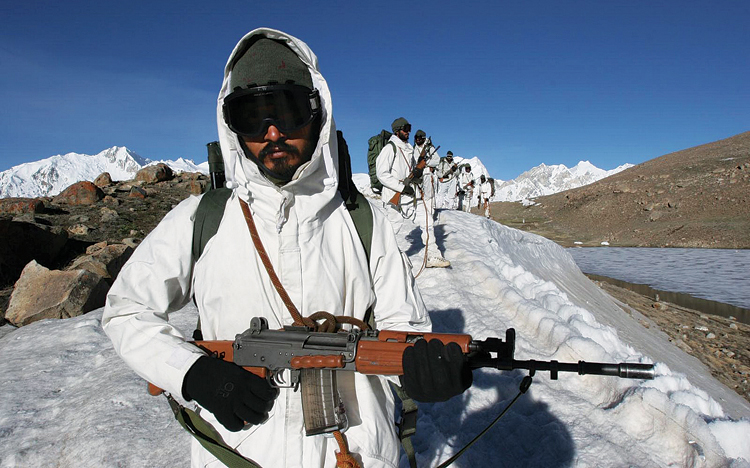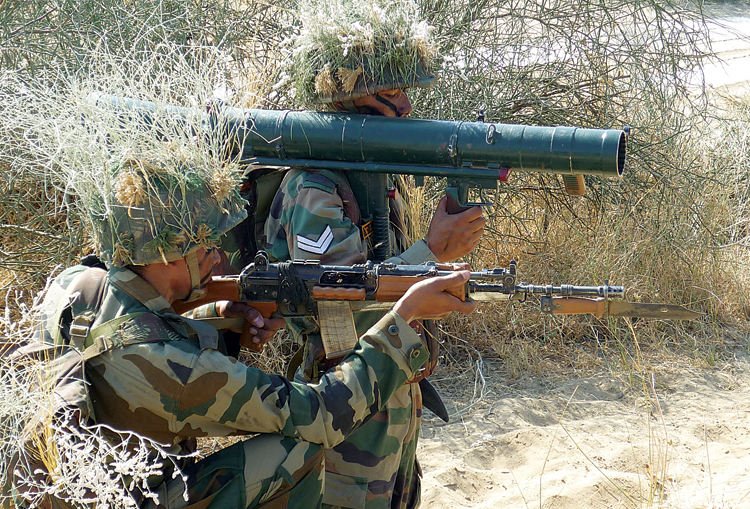INDIAN ARMED FORCES CHIEFS ON OUR RELENTLESS AND FOCUSED PUBLISHING EFFORTS

The insightful articles, inspiring narrations and analytical perspectives presented by the Editorial Team, establish an alluring connect with the reader. My compliments and best wishes to SP Guide Publications.

"Over the past 60 years, the growth of SP Guide Publications has mirrored the rising stature of Indian Navy. Its well-researched and informative magazines on Defence and Aerospace sector have served to shape an educated opinion of our military personnel, policy makers and the public alike. I wish SP's Publication team continued success, fair winds and following seas in all future endeavour!"

Since, its inception in 1964, SP Guide Publications has consistently demonstrated commitment to high-quality journalism in the aerospace and defence sectors, earning a well-deserved reputation as Asia's largest media house in this domain. I wish SP Guide Publications continued success in its pursuit of excellence.
- Appointments Committee of Cabinet approves one-month extension in service of Chief of the Army Staff
- Prime Minister witnesses 'Bharat Shakti' – a Tri-Services Firing and Manoeuvre Exercise in Pokhran, Rajasthan
- Interim Defence Budget 2024-25 — An Analysis
- Union Defence budget 2024
- Indian Army: In quest of greater firepower and policy recommendations for gaps
- Indian Army Annual Press Conference 2024
- Tata Boeing Aerospace Delivers 250 AH-64 Apache Fuselages, Manufactured in India
The Infantry — The Buck Stops at its Feet
Infantry the world over has kept pace with the evolution of warfare. However, the Indian Army is lagging behind in its efforts to keep the Infantry comparable to the best in the world as far as its weapon and equipment profile is concerned. The Infantry of the Indian Army is in dire need of all round improvement especially in the areas of survivability, lethality and mobility.

Introduction
History of warfare is replete with examples where Nations have won the war but lost the campaign. While several factors may have contributed to the defeat of the aggressors in these wars but the quality of Infantry soldiers, their will to fight and unconventional strategy has been a major factor. Over dependence on technology, firepower especially in a predominantly unconventional battlefield and terrain such as mountains, high altitude, super high altitude areas (HAA & SHAA) and jungle terrain which are highly conducive for guerilla warfare and low intensity conflicts has been the nemesis of many super powers. While human resource of all arms are essential for conduct of successful battle, bulk of our operations are dependent on the Infantry and Armour. Of these the infantry is almost entirely dependent on the “skill and will to fight” of its soldier? An Infantry man combines in him the twin function of platform and the weapon both. Further, one cannot do away with the infantry as it is the infantry which can traverse where no other arm can go. It is the ultimate arm to secure territory for any armed forces to claim victory.
Infantry an Indispensable Arm
Land warfare doctrine, nature of threat, operational geography and availability of technology decide the shape and structure of various arms in the Army including the Infantry. Nature of threat facing the country is unique. India is challenged by two major adversaries on either side of its land frontier. Northern and Eastern Borders are being constantly transgressed by the Chinese in the disputed areas since 1962. Their activities have gathered more pace since the 1998 nuclear tests. In addition, India continues to face threats across its Western borders since ages, making it look inwards and focus on territorial integrity rather than adopting an offensive approach. This forces the country to commit boots on ground to secure its land frontiers as it has to contend with a ‘no-war, no-peace’ scenario.
India has 14,103 kms of land borders of which 2,912 km is with Pakistan and 3,380 Km with China. This constrains the extent to which one can undertake an offensive against each other, hence low level conflicts in the form of border clashes and transgressions are a norm along the northern and the eastern borders. To deal with such threats there is a need for special forces and infantry backed by disruptive technologies.
Territorial Disputes along the Chinese as well as the Pakistani frontier with India are in plenty. Typically any territory under active dispute demands commitment of troops on ground to ensure territorial sovereignty.
Operational Geography of our land frontiers also constrains our ability to defend territories despite availability disruptive technologies. The entire border of India with China amounting to 3,380 km is mountainous, HAA or SHAA which needs predominantly Infantry to ensure territorial integrity. The impact and efficacy of firepower, communication, surveillance and other electronic equipment are restricted due to terrain and weather conditions. Also India has a long maritime domain comprising major Islands which need to be defended and entails boots on ground.
Efficacy of Technology in mountains as highlighted earlier will be limited be it air power, surveillance equipment, missiles, rockets, guns and tanks. Russia has carried out an in-depth analysis of the Nagorno - Karabakh conflict and have come to the conclusion that while the technology did play the deciding factor, it was the quality of troops (boots on ground) that also mattered. The role of Infantry will remain critical and central to success in battle.

Internal Security commitment of the country ideally should not be allocated to the military. However, where such problems exist in close proximity to international unsettled and disturbed borders, then such responsibilities are best managed by the Army. China has also started following the theaterisation of their military and have allocated the responsibility of the defence of borders to the Theatre Commander i.e. PLA and not the Border Defence Regiments. Therefore, the requirement of the Infantry will continue to remain unchanged.
In the plains and the dessert sectors, there is a scope for reducing the Infantry provided it is backed by extensive mechanisation, improved mobility, lethality, and survivability. The battle field must incorporate disruptive technologies, overwhelming ground based firepower especially by the artillery, rockets and missiles and most importantly preponderance of air power for successful conduct of air — land battle.
The Shape and Structure of Infantry of the Future
Infantry the world over has kept pace with the evolution of warfare. However, the Indian Army is lagging behind in its efforts to keep the Infantry comparable to the best in the world as far as its weapon and equipment profile is concerned. The Infantry of the Indian Army is in dire need of all round improvement especially in the areas of survivability, lethality and mobility. Structural changes required in the Infantry are as follows:
- Standard Infantry battalion would still be relevant in the Indian context but with a different outlook. Some of the fundamental transformations envisaged are:
- Mobility and protection to key mobile elements of Infantry Battalion vulnerable to air and ground threats.
- Enhanced range organic fire power for greater self-reliance, lethality and staying power. Induction of 72,000 SiG Assault Rifles considered one of the best Assault Rifles which I have personally used while serving in the National Security Guard is a step in the right direction. Similarly, induction of the AK-203 through indigenous route besides strengthening the infantry will contribute towards Atmanirbhar Bharat initiative in Defence Sector.
- Capability to operate across the entire spectrums of conflict, including in an expeditionary role.
- Network centricity for better Identification of Friend or Foe (IFF), combined arms situational awareness and multi-spectrum communication compatibility. However care needs to be taken that he does not get overloaded with unwanted information.
- Mountain Infantry Battalion besides retaining most of the capabilities of Standard Infantry Battalion, must possess following additional capabilities:-
- An infantry soldier must be equipped with survival gear in cold and extreme cold climate.
- The equipment and weapon profile must be lighter and capable of functioning effectively in cold and extra cold climate.
- Within the constraints of mountainous terrain and weather conditions the Infantry Unit must be relatively more mobile than hither to fore. Where feasible specialist vehicles to negotiate difficult terrain must be authorised in greater numbers such as all terrain vehicles, snow scooters and track expedients.
- Capability to fight for prolonged periods in isolated sectors.
- Authorisation of snippers in larger numbers with the flexibility to be employed either distributed to companies or concentrated as per the situation.
- Capability to leverage disruptive technologies like drones, EW, and robotics.
- Mechanised Infantry (Tracked)’s present equipment profile, organisation and structure of Mechanised Infantry needs no major overhaul but need for enhancement in certain key capabilities are as follows:
- Short range quick reaction Air Defence capability against low flying anti-ground forces fixed wing / rotary wing aircrafts over and above the existing anti-aircraft capability of 30mm canon of BMP-II platform.
- Upgraded Battlefield Surveillance Radar cover with enhanced range for better stand-off surveillance capability.
- Dedicated sub-unit for long range sniping capability.
- Upgrade mortars to 120mm Mortar systems with due modification of the existing platform.
- Motorised Infantry (Wheeled) with survivability, lethality and maneuverability of Infantry on the Western Front requires major up-gradation with the induction of motorised platform (wheeled) in line with the terrain profile of the western borders. The wheeled platform should be ‘Make in India’ model for logistic and monetary ease of maintenance and procurement. It must possess most of the capabilities of a mechanised infantry battalion, with some exceptions in capabilities related to firepower, armour protection and all terrain mobility.
- Tailor-made Specialised Forces. The diverse nature of terrain configuration and threat profile do not permit ‘One Size Fits All’ approach in the organisational construct of Infantry. Some suggestions are as follows:
- Scouts battalion concept was first coined in 1948 with the raising of ‘NUBRA GUARDS’, now LADAKH SCOUTS, to guard rugged and inaccessible Indo-Tibetan border of the Eastern Ladakh. Post revitalisation of northern borders in the wake of Galwan incident, the capabilities of these lightly equipped troops require augmentation by undertaking following measures:-
- Re-organising requisite number of existing infantry battalions with homogeneous ethnicity into Scouts battalions to increase availability of troops with reduced reaction time and familiarity with terrain and local customs.
- Restructure Scouts battalions on the lines of Special Forces.
- Special/Light Infantry Battalions need to be raised for Operational penetration on the lines of SF to offset their shortages. These troops must have special physiological attributes, knowledge of terrain and customs to survive in the hostile environment based on the sons of the soil concept to reduce reaction time.
Conclusion
As evident from the preceding discussions India is also in the midst of a transformation of its Infantry, but its progress is tardy especially in equipping it. The personal weapon needs early replacement and force multipliers in terms of anti-tank, point air defence, disruptive, communication and electronic warfare capabilities need urgent improvement and attention on priority. Given the presence of multiple threats, it would be in our larger national interest to strengthen the military including the Infantry by making it future ready to respond in all spectrums of warfare as part of a Tri Service Combined Arms Integrated Response.
The author is Ex Corps Commander 11 Corps, Ex Chief of Staff Eastern Command, Ex Commandant Army War College and Ex IG (Ops) NSG.





